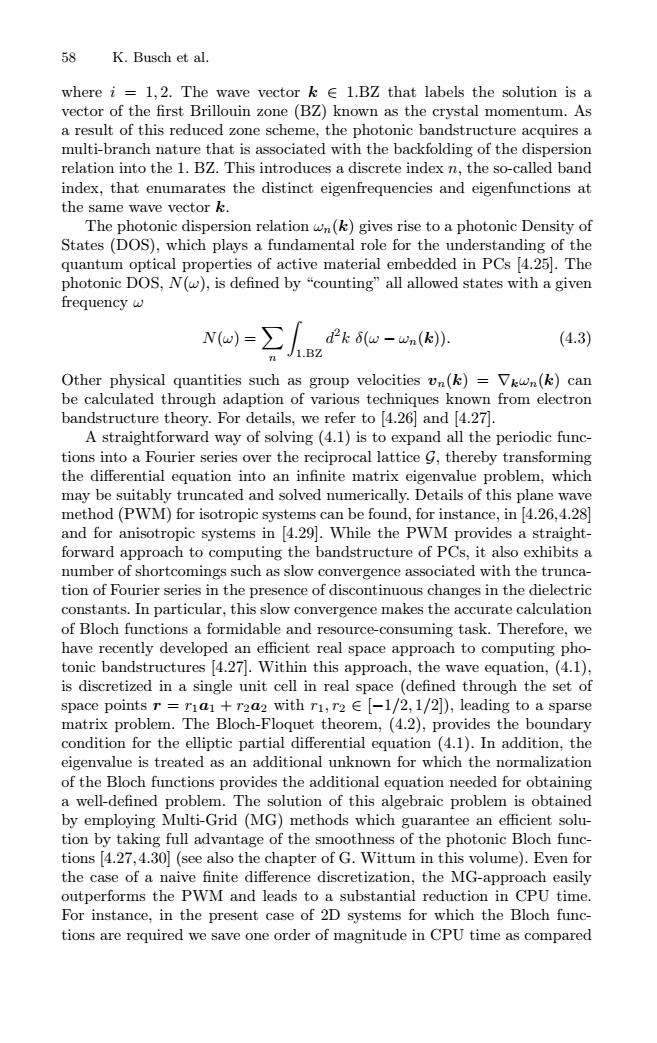正在加载图片...

58 K.Busch et al. where i=1,2.The wave vector k E 1.BZ that labels the solution is a vector of the first Brillouin zone (BZ)known as the crystal momentum.As a result of this reduced zone scheme,the photonic bandstructure acquires a multi-branch nature that is associated with the backfolding of the dispersion relation into the 1.BZ.This introduces a discrete index n,the so-called band index,that enumarates the distinct eigenfrequencies and eigenfunctions at the same wave vector k. The photonic dispersion relation wn(k)gives rise to a photonic Density of States (DOS),which plays a fundamental role for the understanding of the quantum optical properties of active material embedded in PCs [4.25].The photonic DOS,N(w),is defined by "counting"all allowed states with a given frequency w d2k 6(w-wn(k)). (4.3) Other physical quantities such as group velocities vn(k)=Vkwn(k)can be calculated through adaption of various techniques known from electron bandstructure theory.For details,we refer to [4.26]and [4.27]. A straightforward way of solving(4.1)is to expand all the periodic func- tions into a Fourier series over the reciprocal lattice 9,thereby transforming the differential equation into an infinite matrix eigenvalue problem,which may be suitably truncated and solved numerically.Details of this plane wave method (PWM)for isotropic systems can be found,for instance,in [4.26,4.28 and for anisotropic systems in [4.29].While the PWM provides a straight- forward approach to computing the bandstructure of PCs,it also exhibits a number of shortcomings such as slow convergence associated with the trunca- tion of Fourier series in the presence of discontinuous changes in the dielectric constants.In particular,this slow convergence makes the accurate calculation of Bloch functions a formidable and resource-consuming task.Therefore,we have recently developed an efficient real space approach to computing pho- tonic bandstructures [4.27].Within this approach,the wave equation,(4.1), is discretized in a single unit cell in real space (defined through the set of space points r=ria1+r2a2 with r1,r2 E [-1/2,1/2]),leading to a sparse matrix problem.The Bloch-Floquet theorem,(4.2),provides the boundary condition for the elliptic partial differential equation(4.1).In addition,the eigenvalue is treated as an additional unknown for which the normalization of the Bloch functions provides the additional equation needed for obtaining a well-defined problem.The solution of this algebraic problem is obtained by employing Multi-Grid (MG)methods which guarantee an efficient solu- tion by taking full advantage of the smoothness of the photonic Bloch func- tions [4.27,4.30](see also the chapter of G.Wittum in this volume).Even for the case of a naive finite difference discretization,the MG-approach easily outperforms the PWM and leads to a substantial reduction in CPU time. For instance,in the present case of 2D systems for which the Bloch func- tions are required we save one order of magnitude in CPU time as compared58 K. Busch et al. where i = 1, 2. The wave vector k ∈ 1.BZ that labels the solution is a vector of the first Brillouin zone (BZ) known as the crystal momentum. As a result of this reduced zone scheme, the photonic bandstructure acquires a multi-branch nature that is associated with the backfolding of the dispersion relation into the 1. BZ. This introduces a discrete index n, the so-called band index, that enumarates the distinct eigenfrequencies and eigenfunctions at the same wave vector k. The photonic dispersion relation ωn(k) gives rise to a photonic Density of States (DOS), which plays a fundamental role for the understanding of the quantum optical properties of active material embedded in PCs [4.25]. The photonic DOS, N(ω), is defined by “counting” all allowed states with a given frequency ω N(ω) = n 1.BZ d2k δ(ω − ωn(k)). (4.3) Other physical quantities such as group velocities vn(k) = ∇kωn(k) can be calculated through adaption of various techniques known from electron bandstructure theory. For details, we refer to [4.26] and [4.27]. A straightforward way of solving (4.1) is to expand all the periodic functions into a Fourier series over the reciprocal lattice G, thereby transforming the differential equation into an infinite matrix eigenvalue problem, which may be suitably truncated and solved numerically. Details of this plane wave method (PWM) for isotropic systems can be found, for instance, in [4.26,4.28] and for anisotropic systems in [4.29]. While the PWM provides a straightforward approach to computing the bandstructure of PCs, it also exhibits a number of shortcomings such as slow convergence associated with the truncation of Fourier series in the presence of discontinuous changes in the dielectric constants. In particular, this slow convergence makes the accurate calculation of Bloch functions a formidable and resource-consuming task. Therefore, we have recently developed an efficient real space approach to computing photonic bandstructures [4.27]. Within this approach, the wave equation, (4.1), is discretized in a single unit cell in real space (defined through the set of space points r = r1a1 + r2a2 with r1, r2 ∈ [−1/2, 1/2]), leading to a sparse matrix problem. The Bloch-Floquet theorem, (4.2), provides the boundary condition for the elliptic partial differential equation (4.1). In addition, the eigenvalue is treated as an additional unknown for which the normalization of the Bloch functions provides the additional equation needed for obtaining a well-defined problem. The solution of this algebraic problem is obtained by employing Multi-Grid (MG) methods which guarantee an efficient solution by taking full advantage of the smoothness of the photonic Bloch functions [4.27,4.30] (see also the chapter of G. Wittum in this volume). Even for the case of a naive finite difference discretization, the MG-approach easily outperforms the PWM and leads to a substantial reduction in CPU time. For instance, in the present case of 2D systems for which the Bloch functions are required we save one order of magnitude in CPU time as compared